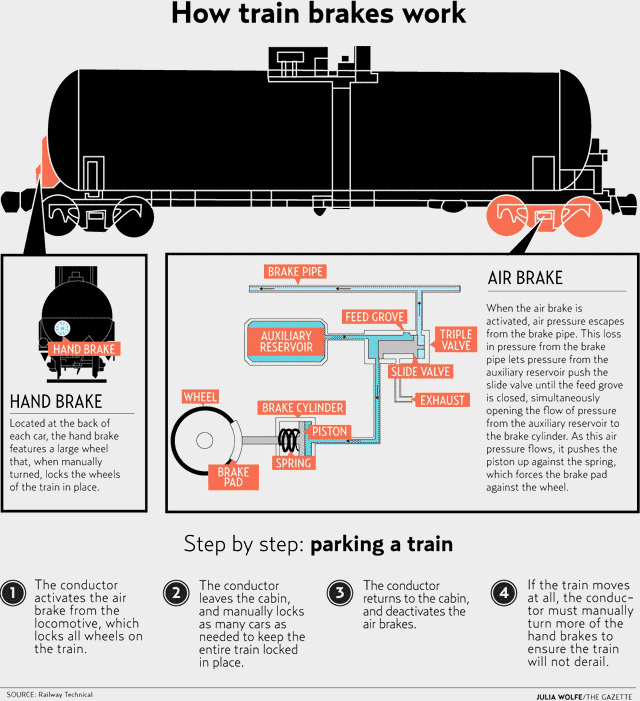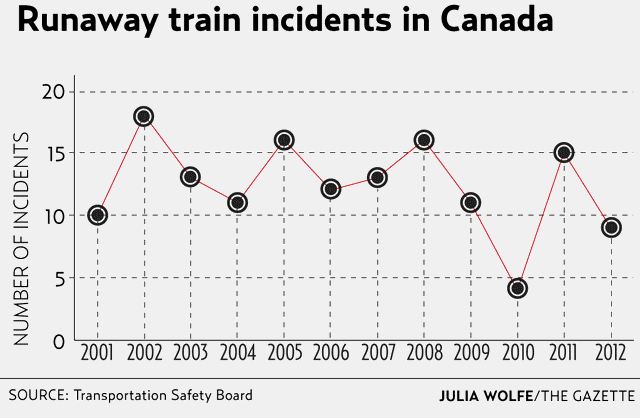

9 July 2013 What Causes a Runaway Train? Lake Megantic Quebec - Three days after the small town of Lake Megantic was decimated by a runaway train, new questions are surfacing about how a 10,000-tonne vehicle was able to break loose and careen down 11 kilometres of track, seemingly unhindered.
Late Sunday, the company that owned the doomed train, Montreal Maine & Atlantic Railway (MMA), issued a statement that singled out a failure of the train's air brakes as a possible culprit.
"One fact that has emerged is that the locomotive of the oil train parked at Nantes station was shut down subsequent to the departure of the engineer who had handled the train from Farnham, which may have resulted in the release of air brakes on the locomotive that was holding the train in place."
It's not clear what caused that engine shutdown, but a small fire that erupted in one of the locomotives around 11:30 p.m. Friday might have been to blame. That first fire was quickly extinguished, authorities have confirmed, but sometime later, the train slowly began to roll downhill toward the town of 6,000 residents. It picked up speed, then derailed and exploded at approximately 1:30 a.m.
According to several rail switchmen and engineers contacted by The Gazette on Monday, the company's explanation involving the air brakes simply doesn't make sense.
A train's air brakes rely on a system of pressure valves and storage tanks to function, but they should never be used to maintain a train at rest over an extended period of time. According to retired engineer Paul-Andre Larose, when the engines are shut off, air gradually begins to leak out of the system, like a balloon with a tiny puncture, and eventually the breaks disengage.
"The air brake system is a beautiful concept, but you have to know its limitations," said Larose, who lives in Toronto.
That's where the manually engaged "hand brakes" come in. Even if the air brakes on the MMA train had stopped working, explained veteran rail worker Don Beyer, a backup series of hand brakes should have been engaged, and they should have been enough to keep the train stationary.
"You set hand brakes to prevent the train from rolling," said Beyer, who has more than 30 years of experience and works as a switchman in a busy rail yard in Missouri.
Each MMA locomotive and tank car was equipped with a hand brake. If the conductor was planning to leave the train unmanned for even a brief period, both Beyer and Larose say, he should have manually "tied" as many of these hand brakes as he thought would be needed, using a wheel crank located at the back of each car. He should then have gone back to the front of the train, disengaged the air brakes, and waited to see if the train moved.

Larose noted that even if the huge vehicle didn't start to slide on its own, the conductor should have tried to push the train forward by activating the engine (applying enough horsepower to simulate a strong gust of wind, for example). No movement would have meant the train was securely rooted to the track.
Transport Canada's rules governing train travel specifically outline this procedure, which Beyer referred to as a "securement test." Section 112 of the Canadian Railway Operating Rules stipulates that "when equipment is left at any point, a sufficient number of hand brakes must be applied to prevent it from moving. Before relying on the retarding force of the hand brakes, whether leaving equipment or riding equipment to rest, the effectiveness of the hand brakes must be tested."
MMA officials confirmed to The Gazette that hand brakes were engaged on all five of the train's locomotive cars, but it's unclear how many of the 72 tanker cars, each carrying tens of thousands of litres of crude oil, had their hand brakes activated. It's also unclear whether the securement test was performed. If it wasn't, and the hand brakes couldn't hold the train, then that could explain how it was able to begin rolling toward Lake Megantic.
In an interview with The Gazette on Monday, MMA chairman Ed Burkhardt said he believes the locomotive was tampered with.
But according to Rob Smith, national legislative director with Teamsters Canada Rail Conference, the possibility of vandals releasing the manual brakes is slim.
"It's not as easy as it might seem. You would have to know what you're doing," he said.
Larose noted that when it comes to performing safety checks, "choosing the path of least resistance" can lead to deadly results.
"The corporate world has thrown away all the expertise we had on the railway. And now we wonder why we're having accidents," he added. "Until there's an accident, they don't really think about these things."
Monique Muise.



Vancouver Island
British Columbia
Canada
| 


